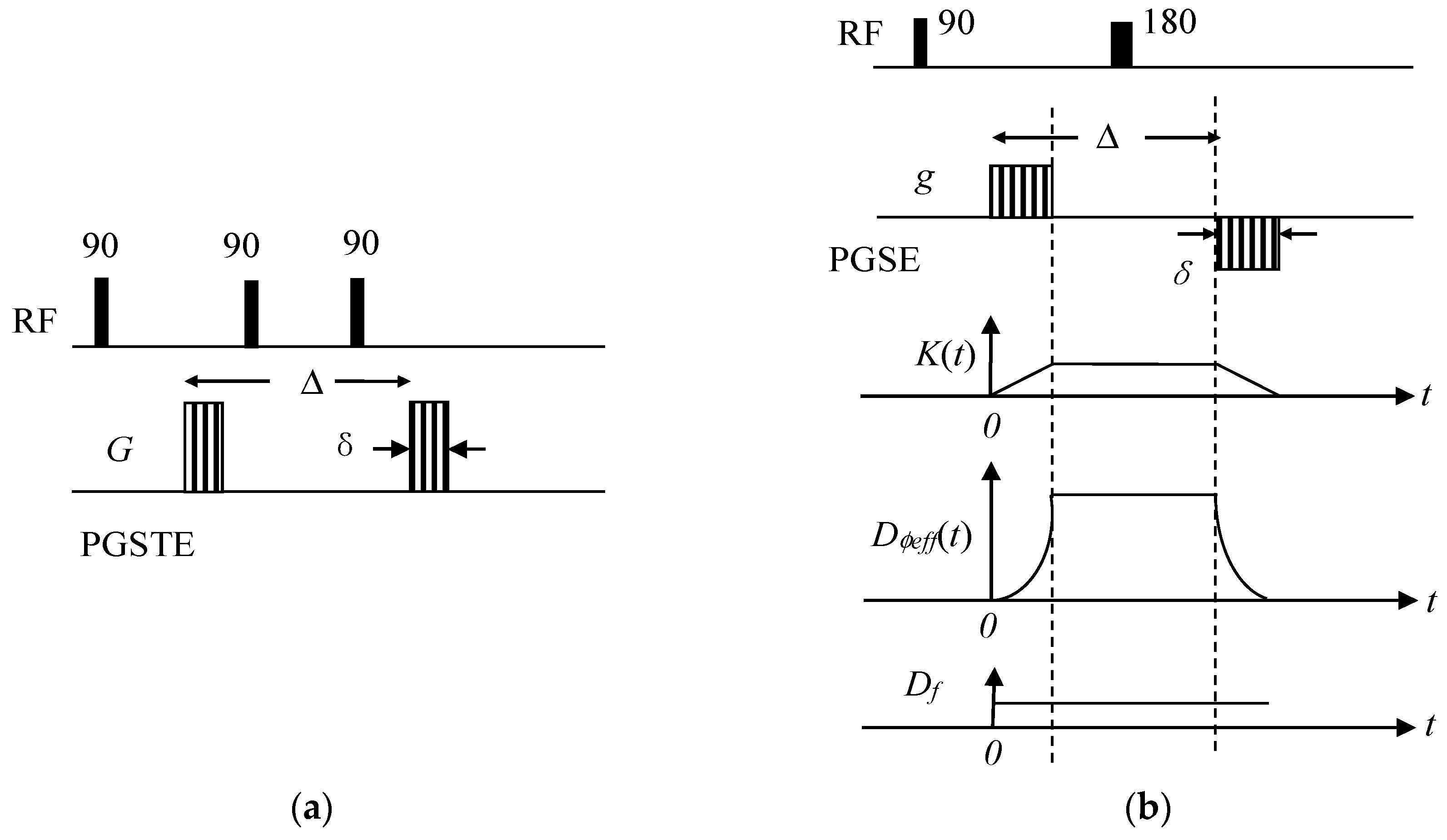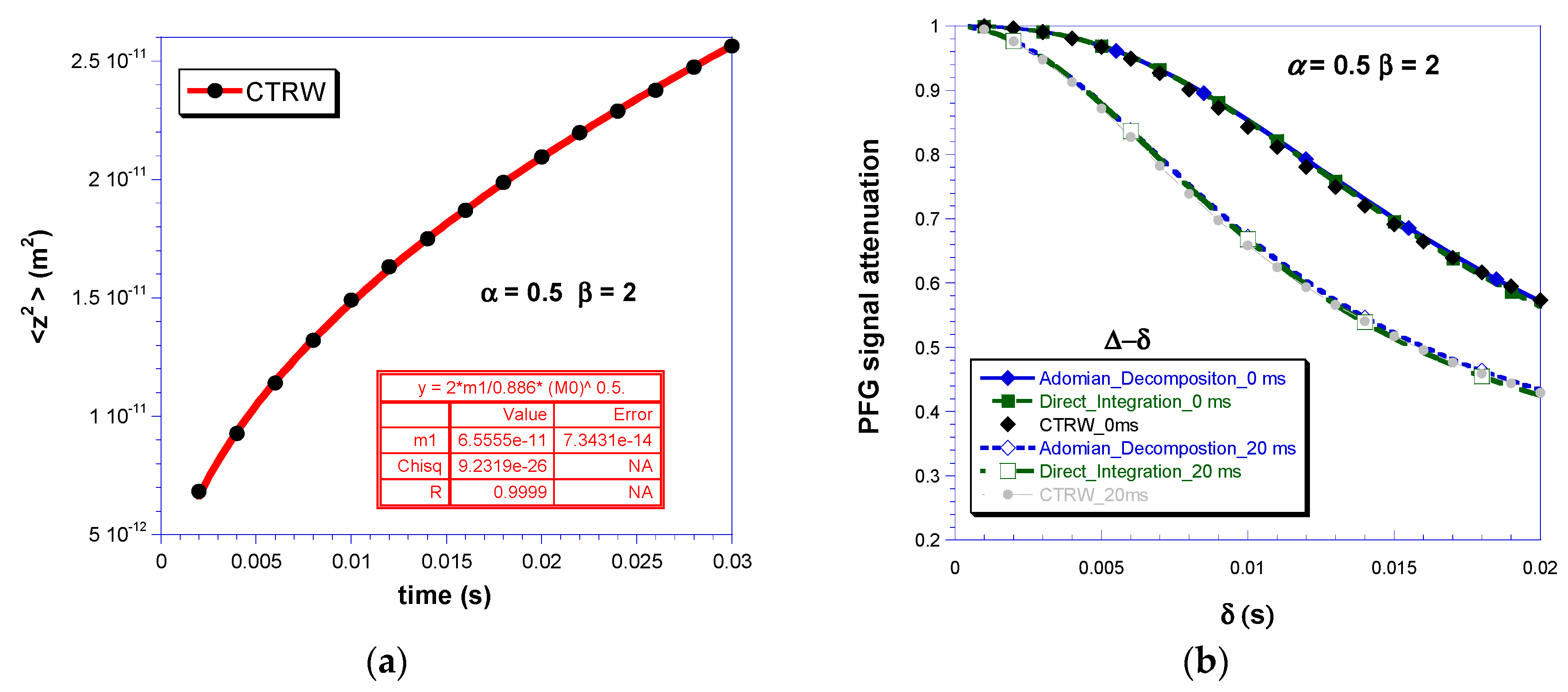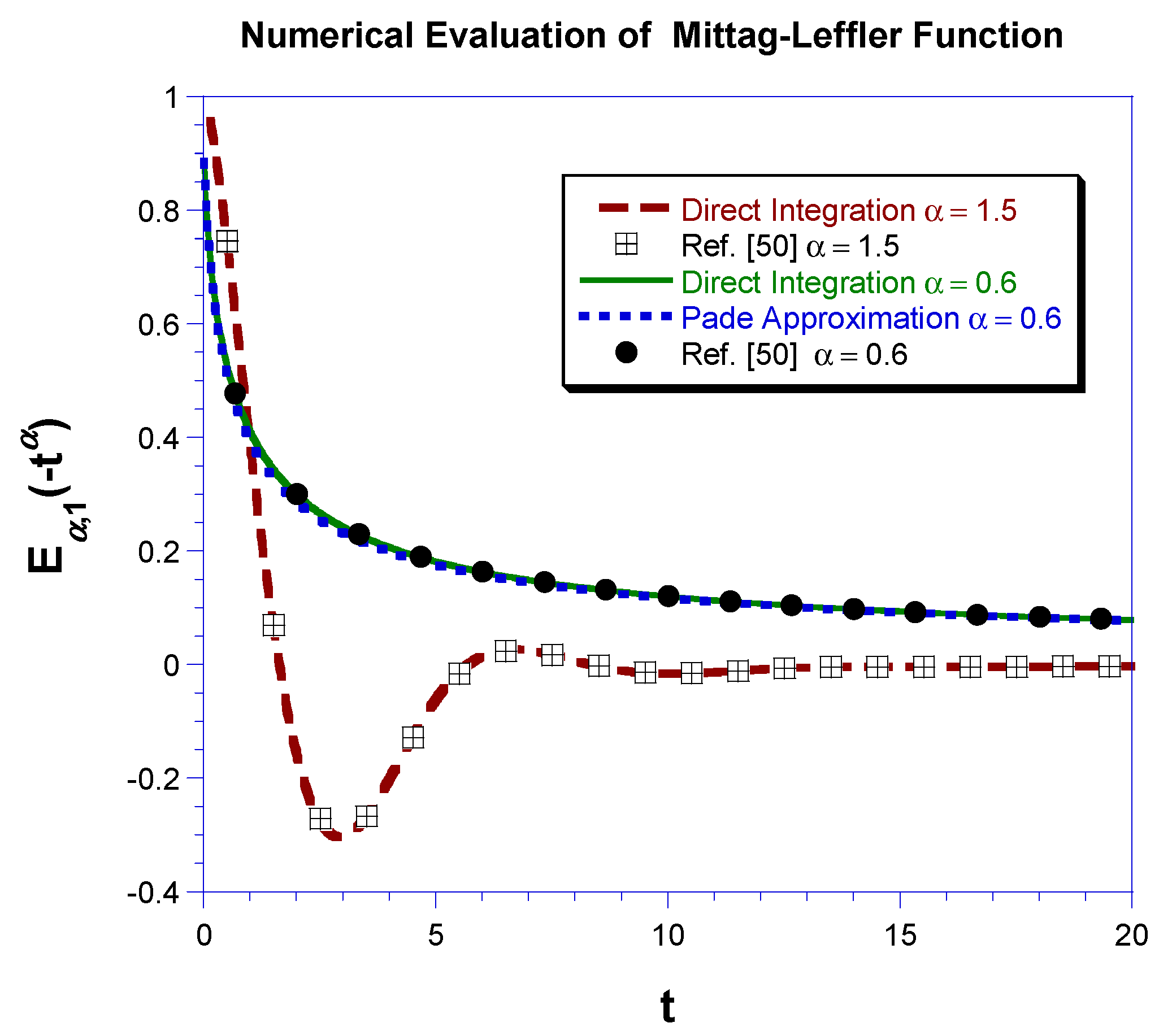Analysis of PFG Anomalous Diffusion via Real-Space and Phase-Space Approaches
Abstract
:1. Introduction
2. Theory
2.1. The Phase-Space Method: The Effective Phase-Shift Diffusion Method
2.2. Observing the Signal Intensity at the Origin in Real Space
2.3. Analytical Solution by the Adomian Decomposition Method
2.3.1. Normal Diffusion
2.3.2. General Anomalous Diffusion
- (a)
- (b)
- Single pulse attenuation: This is an ideal situation—the first gradient pulse is regular, but the second gradient pulse is infinitely narrow and has the purpose of counteracting the first gradient pulse. We getwhere , and is a Mittag-Leffler-type function [43]. Equation (24) is consistent with the results obtained by the modified Bloch equation proposed in [25].
- (c)
- General PFG signal attenuation: The PGSE or PGSTE experiment includes three periods: , , and . The integration in Equation (22c) during these three periods is tedious, but can be calculated with computer assistance. Nevertheless, we can get the first and second terms of Equation (22a) as the following:where B(x,y) and B(a;x,y) are the Beta function and incomplete Beta function, respectively. When , Equation (25b) gives
2.4. Numerical Evaluation of Mittag-Leffler Function-Based PFG Signal Attenuation by the Direct Integration Method
3. Continuous-Time Random Walk (CTRW) in a Lattice Model
4. Results and Discussion
Conflicts of Interest
Appendix A. Definition of the Fractional Derivative
References
- Wyss, W. The fractional diffusion equation. J. Math. Phys. 1986, 27, 2782–2785. [Google Scholar] [CrossRef]
- Metzler, R.; Klafter, J. The random walk’s guide to anomalous diffusion: A fractional dynamics approach. Phys. Rep. 2000, 339, 1–77. [Google Scholar] [CrossRef]
- Sokolov, I.M. Models of anomalous diffusion in crowded environments. Soft Matter 2012, 8, 9043–9052. [Google Scholar] [CrossRef]
- Povstenko, Y. Linear Fractional Diffusion-Wave Equation for Scientists and Engineers; Birkhäuser: New York, NY, USA, 2015. [Google Scholar]
- Köpf, M.; Corinth, C.; Haferkamp, O.; Nonnenmacher, T.F. Anomalous diffusion of water in biological tissues. Biophys. J. 1996, 70, 2950–2958. [Google Scholar] [CrossRef]
- Saichev, A.I.; Zaslavsky, G.M. Fractional kinetic equations: Solutions and applications. Chaos 1997, 7, 753–764. [Google Scholar] [CrossRef] [PubMed]
- Lindsey, C.P.; Patterson, G.D. Detailed comparison of the Williams–Watts and Cole-Davidson functions. J. Chem. Phys. 1980, 73, 3348–3357. [Google Scholar] [CrossRef]
- Kaplan, J.I.; Garroway, A.N. Homogeneous and inhomogeneous distributions of correlation times. Lineshapes for chemical exchange. J. Magn. Reson. 1982, 49, 464–475. [Google Scholar] [CrossRef]
- Hahn, E.L. Spin echoes. Phys. Rev. 1950, 80, 580–594. [Google Scholar] [CrossRef]
- Torrey, H.C. Bloch Equations with Diffusion Terms. Phys. Rev. 1956, 104, 563–565. [Google Scholar] [CrossRef]
- McCall, D.W.; Douglass, D.C.; Anderson, E.W. Self-diffusion studies by means of nuclear magnetic resonance spin-echo techniques. Ber. Bunsenges. Phys. Chem. 1963, 67, 336–340. [Google Scholar] [CrossRef]
- Stejskal, E.O.; Tanner, J.E. Spin diffusion measurements: Spin echoes in the presence of a time-dependent field gradient. J. Chem. Phys. 1965, 42, 288–292. [Google Scholar] [CrossRef]
- Price, W.S. Pulsed-field gradient nuclear magnetic resonance as a tool for studying translational diffusion: Part 1. Basic theory. Concepts Magn. Reson. 1997, 9, 299–336. [Google Scholar] [CrossRef]
- Price, W.S. NMR Studies of Translational Motion: Principles and Applications; Cambridge University Press: Cambridge, UK, 2009. [Google Scholar]
- Callaghan, P. Translational Dynamics and Magnetic Resonance: Principles of Pulsed Gradient Spin Echo NMR; Oxford University Press: Oxford, UK, 2011. [Google Scholar]
- McRobbie, D.W.; Moore, E.A.; Graves, M.J.; Prince, M.R. MRI from Picture to Proton, 2nd ed.; Cambridge University Press: Cambridge, UK, 2007; p. 338. [Google Scholar]
- Magin, R.L.; Abdullah, O.; Baleanu, D.; Zhou, X.J. Anomalous diffusion expressed through fractional order differential operators in the Bloch–Torrey equation. J. Magn. Reson. 2008, 190, 255–270. [Google Scholar] [CrossRef] [PubMed]
- Lin, G. An effective phase shift diffusion equation method for analysis of PFG normal and fractional diffusions. J. Magn. Reson. 2015, 259, 232–240. [Google Scholar] [CrossRef] [PubMed]
- Kärger, J.; Pfeifer, H.; Vojta, G. Time correlation during anomalous diffusion in fractal systems and signal attenuation in NMR field-gradient spectroscopy. Phys. Rev. A 1988, 37, 4514–4517. [Google Scholar] [CrossRef]
- Kimmich, R. NMR: Tomography, Diffusometry, Relaxometry; Springer: Heidelberg, Germany, 1997. [Google Scholar]
- Fatkullin, N.; Kimmich, R. Theory of field-gradient NMR diffusometry of polymer segment displacements in the tube-reptation model. Phys. Rev. E 1995, 52, 3273–3276. [Google Scholar] [CrossRef]
- Bennett, K.M.; Schmainda, K.M.; Bennett, R.T.; Rowe, D.B.; Lu, H.; Hyde, J.S. Characterization of continuously distributed cortical water diffusion rates with a stretched-exponential model. Magn. Reson. Med. 2003, 50, 727–734. [Google Scholar] [CrossRef] [PubMed]
- Bennett, K.M.; Hyde, J.S.; Schmainda, K.M. Water diffusion heterogeneity index in the human brain is insensitive to the orientation of applied magnetic field gradients. Magn. Reson. Med. 2006, 56, 235–239. [Google Scholar] [CrossRef] [PubMed]
- Klafter, J.; Sokolov, I.M. First Step in Random Walks. From Tools to Applications; Oxford University Press: New York, NY, USA, 2011. [Google Scholar]
- Hanyga, A.; Seredyńska, M. Anisotropy in high-resolution diffusion-weighted MRI and anomalous diffusion. J. Magn. Reson. 2012, 220, 85–93. [Google Scholar] [CrossRef] [PubMed]
- Lin, G. Instantaneous signal attenuation method for analysis of PFG fractional diffusions. J. Magn. Reson. 2016, 269, 36–49. [Google Scholar] [CrossRef] [PubMed]
- Lin, G. Analyzing signal attenuation in PFG anomalous diffusion via a non-gaussian phase distribution approximation approach by fractional derivatives. J. Chem. Phys. 2016, 145, 194202. [Google Scholar] [CrossRef] [PubMed]
- Lin, G.; Zheng, S.; Liao, X. Signal attenuation of PFG restricted anomalous diffusions in plate, sphere, and cylinder. J. Magn. Reson. 2016, 272, 25–36. [Google Scholar] [CrossRef] [PubMed]
- Damion, R.A.; Packer, K.J. Predictions for pulsed-field-gradient NMR experiments of diffusion in fractal spaces. Proc. Math. Phys. Eng. Sci. 1997, 453, 205–211. [Google Scholar] [CrossRef]
- Lin, G. The exact PFG signal attenuation expression based on a fractional integral modified-Bloch equation. arXiv, 2017; arXiv:1706.02026. [Google Scholar]
- Lin, G. Fractional differential and fractional integral modified-Bloch equations for PFG anomalous diffusion and their general solutions. arXiv, 2017; arXiv:1702.07116. [Google Scholar]
- Mainardi, F.; Luchko, Y.; Pagnini, G. The fundamental solution of the space-time-fractional diffusion equation. Fract. Calc. Appl. Anal. 2001, 4, 153–192. [Google Scholar]
- Gorenflo, R.; Mainardi, F. Fractional Diffusion Processes: Probability Distributions and Continuous Time Random Walk. In Processes with Long-Range Correlations. Theory and Applications; Rangarajan, G., Ding, M., Eds.; Lecture Notes in Physics, No. 621; Springer: Berlin, Germany, 2003; pp. 148–166. [Google Scholar]
- Balescu, R. V-Langevin equations, continuous time random walks and fractional diffusion. Chaos Solitons Fract. 2007, 34, 62–80. [Google Scholar] [CrossRef]
- Mittal, R.C.; Nigam, R. Solution of fractional integro-differential equations by Adomian decomposition method. Int. J. Appl. Math. Mech. 2008, 4, 87–94. [Google Scholar]
- Adomian, G. Solving Frontier Problems of Physics: The Decomposition Method; Kluwer Academic: Dordrecht, The Netherlands, 1994. [Google Scholar]
- Adomian, G.; Rach, R. Inversion of nonlinear stochastic operators. J. Math. Anal. Appl. 1983, 91, 39–46. [Google Scholar] [CrossRef]
- Adomian, G.; Rach, R. On the solution of algebraic equations by the decomposition method. J. Math. Anal. Appl. 1985, 105, 141–166. [Google Scholar] [CrossRef]
- Duan, J.-S.; Rach, R.; Baleanu, D.; Wazwaz, A.-M. A review of the Adomian decomposition method and its applications to fractional differential equations. Commun. Fract. Calc. 2012, 3, 73–99. [Google Scholar]
- Grinberg, F.; Farrher, E.; Ciobanu, L.; Geffroy, F.; Le Bihan, D.; Shah, N.J. Non-Gaussian diffusion imaging for enhanced contrast of brain tissue affected by ischemic stroke. PLoS ONE 2014, 9, e89225. [Google Scholar] [CrossRef] [PubMed]
- Zax, D.; Pines, A. Study of anisotropic diffusion of oriented molecules by multiple quantum spin echoes. J. Chem. Phys. 1983, 78, 6333–6334. [Google Scholar] [CrossRef]
- Karlicek, R.F., Jr.; Lowe, I.J. A modified pulsed gradient technique for measuring diffusion in the presence of large background gradients. J. Magn. Reson. 1980, 37, 75–91. [Google Scholar] [CrossRef]
- Kilbas, A.A.; Saigo, M. Solutions of integral equation of Abel–Volterra type. Differ. Integral Equ. 1995, 8, 993–1011. [Google Scholar]
- Lin, G. General PFG signal attenuation expressions for anisotropic anomalous diffusion by modified-Bloch equations. Physica A 2018. [Google Scholar] [CrossRef]
- Germano, G.; Politi, M.; Scalas, E.; Schilling, R.L. Stochastic calculus for uncoupled continuous-time random walks. Phys. Rev. E 2009, 79, 066102. [Google Scholar] [CrossRef] [PubMed]
- Cicerone, M.T.; Wagner, P.A.; Ediger, M.D. Translational diffusion on heterogeneous lattices: A model for dynamics in glass forming materials. J. Phys. Chem. B 1997, 101, 8727–8734. [Google Scholar] [CrossRef]
- Lin, G.; Zhang, J.; Cao, H.; Jones, A.A. A lattice model for the simulation of diffusion in heterogeneous polymer systems. Simulation of apparent diffusion constants as determined by pulse-field-gradient nuclear magnetic resonance. J. Phys. Chem. B 2003, 107, 6179–6186. [Google Scholar] [CrossRef]
- Lin, G.; Aucoin, D.; Giotto, M.; Canfield, A.; Wen, W.; Jones, A.A. Lattice model simulation of penetrant diffusion along hexagonally packed rods in a barrier matrix as determined by pulsed-field-gradient nuclear magnetic resonance. Macromolecules 2007, 40, 1521–1528. [Google Scholar] [CrossRef]
- Gorenflo, R.; Loutchko, J.; Luchko, Y. Computation of the Mittag-Leffler function Eα,β (z) and its derivative. Fract. Calc. Appl. Anal. 2002, 5, 491–518. [Google Scholar]
- Zeng, C.; Chen, Y. Global Pade approximations of the generalized Mittag-Leffler function and its inverse. Fract. Calc. Appl. Anal. 2015, 18, 1492–1506. [Google Scholar] [CrossRef]
- Chen, W.; Sun, H.; Zhang, X.; Korošak, D. Anomalous diffusion modeling by fractal and fractional derivatives. Comput. Math. Appl. 2010, 59, 1754–1758. [Google Scholar] [CrossRef]
- Le Doussal, P.; Sen, P.N. Decay of nuclear magnetization by diffusion in a parabolic magnetic field: An exactly solvable model. Phys. Rev. B 1992, 46, 3465–3485. [Google Scholar] [CrossRef]



| Virtual Phase-Space Diffusion | Real-Space Spin Diffusion |
|---|---|
| Effective phase-shift diffusion equation [18] | Observing the signal intensity at the origin |
| Diffusion equations: | |
| [18] | [32] |
| Solving methods: | |
| Fourier transform | Substitute into equation |
| PFG signal attenuation equation*: | |
| , | |
| or equivalently | |
| PFG signal attenuation expression by the Adomian decomposition method [30,31]*: | |
| where , and | |
| Under short gradient pulse (SGP) approximation: | |
| At small attenuation: | |
| Other methods: | |
| (1) [25] | |
| (2) [17] | |
| (3) [26] | |
| (4) [18,26,27] | |
© 2018 by the author. Licensee MDPI, Basel, Switzerland. This article is an open access article distributed under the terms and conditions of the Creative Commons Attribution (CC BY) license (http://creativecommons.org/licenses/by/4.0/).
Share and Cite
Lin, G. Analysis of PFG Anomalous Diffusion via Real-Space and Phase-Space Approaches. Mathematics 2018, 6, 17. https://doi.org/10.3390/math6020017
Lin G. Analysis of PFG Anomalous Diffusion via Real-Space and Phase-Space Approaches. Mathematics. 2018; 6(2):17. https://doi.org/10.3390/math6020017
Chicago/Turabian StyleLin, Guoxing. 2018. "Analysis of PFG Anomalous Diffusion via Real-Space and Phase-Space Approaches" Mathematics 6, no. 2: 17. https://doi.org/10.3390/math6020017
APA StyleLin, G. (2018). Analysis of PFG Anomalous Diffusion via Real-Space and Phase-Space Approaches. Mathematics, 6(2), 17. https://doi.org/10.3390/math6020017





